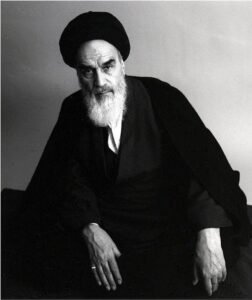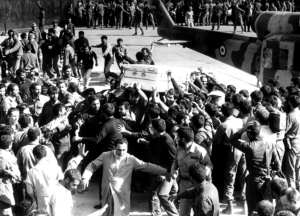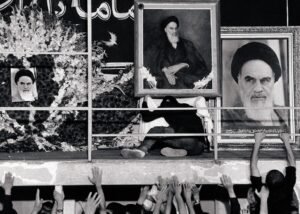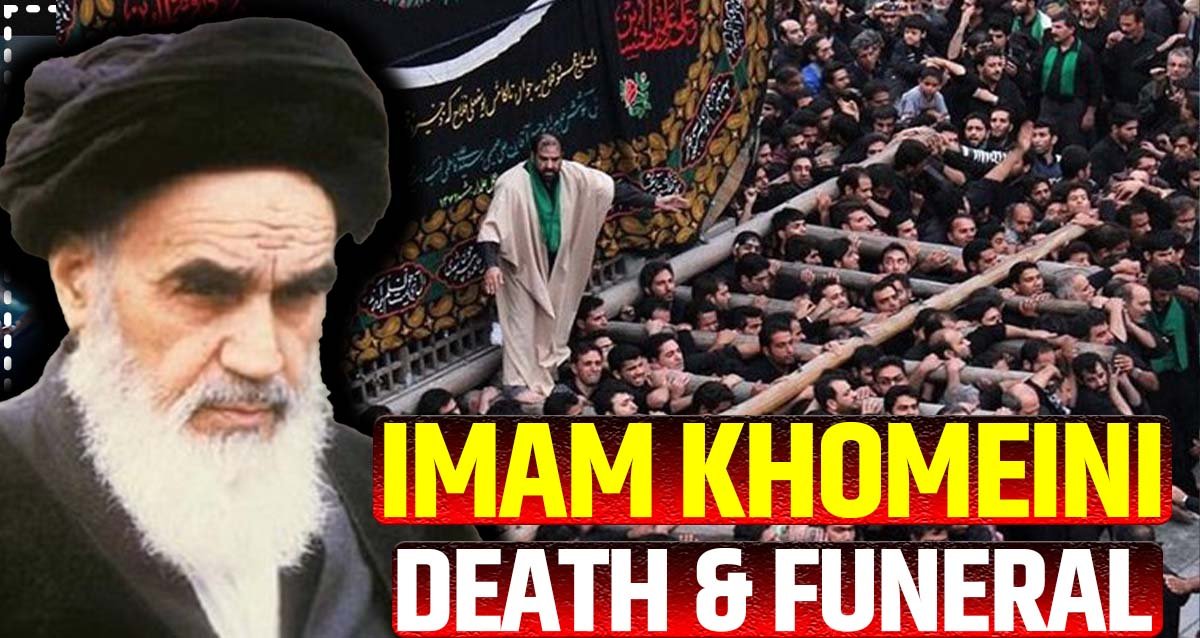Introduction
On the scorching hot day of June 6, 1989, when the body of Imam Khomeini was brought to Behesht-e Zahra Cemetery, a massive crowd of people was present there. In a state of extreme emotion, devotees pushed forward and snatched Imam Khomeini’s body from the revolutionary guards. They began touching and pulling at his shroud as a sacred relic. The crowd was intense, and everyone was trying to move forward to touch the shroud. During this, some individuals started pulling at Imam Khomeini’s shroud so they could keep parts of it as a relic. When a portion of the shroud fell into the hands of the crowd, Imam Khomeini’s feet and legs became visible, and the torn pieces of the shroud were quickly divided among the devotees as relics. In the chaos, the revolutionary guards struggled to retrieve Imam Khomeini’s body from the crowd and placed it back into the helicopter. However, the crowd reached the helicopter and clung to its landing gear, beating their chests in grief. Some devotees even jumped into the grave dug for Imam Khomeini, piling on top of each other and mourning.
The crowd, overwhelmed by their devotion, was unwilling to let go of Imam Khomeini’s body. The revolutionary guards resorted to firing shots in the air and using water cannons to push the crowd back, and with great difficulty, the helicopter managed to take off. However, when the helicopter took off, half of Imam Khomeini’s body was still outside, and a portion of the shroud was fluttering in the wind outside the helicopter door.
Important Questions
What events took place during Imam Khomeini’s funeral and burial?
Why did the people adopt such extreme behavior?
What significant developments occurred in the final days of Imam Khomeini’s life?
Let us discuss the tumultuous final events of Imam Khomeini’s life today.
Last Words of Imam Khomeini

On May 22, 1989, when Imam Khomeini’s health deteriorated, he was admitted to a hospital near his home in Jamaran. Jamaran is a suburban area of Tehran, the capital of Iran. From May 22 to June 3, Imam Khomeini remained in the same hospital. During this period, he suffered five heart attacks.
One day before his death, at 1 o’clock, he called his wife and children to his side. He spoke his final words to them, saying:
“This is a very difficult path… Keep an eye on every word and action of yours… I have nothing more to say.”
After a pause, he spoke again:
“Those who wish to stay, may stay; those who do not, may leave. Turn off the lights, I want to sleep.”
These were the last words of Imam Khomeini. After that, Imam Khomeini’s son Ahmad Khomeini and his daughter Zahra Khomeini stayed by their father’s side. Meanwhile, Khomeini fell into a deep sleep.
Fifth But Last Heart Attack

At three o’clock, he slipped into complete unconsciousness, and rumors about his life and death began circulating in the streets of Tehran. This prompted people to start arriving at the hospital and in Tehran. By late evening, all the important government figures had reached the hospital. At 10 PM, he suffered his fifth and final heart attack. The erratic waves of his life flickered on the monitor beside his bed. At 10:20, a flatline on the monitor confirmed that he was no longer in this world. Ahmad Khomeini and Zahra Khomeini held their father’s hand, kissed it, and bid him farewell. After Khomeini’s death, the country’s leadership abruptly cut off contact with the outside world. Telephone lines were disconnected, airports and borders were sealed, and security at important national installations was heightened. Regarding these measures, Parliamentary Speaker Akbar Ali Hashemi Rafsanjani stated that this was done because there was still a threat from Iraq, fearing they might take advantage of Imam Khomeini’s death to launch an attack.
Key political leaders began consultations to determine the appropriate time to announce Imam Khomeini’s death. They decided not to announce his death until the body was washed, a state of emergency was declared in the country, and a decision on his succession was made. However, the outside world had already become convinced that Imam Khomeini was no longer alive. As a result, millions of his followers in Iran began arriving in Tehran, outside the hospital, at the famous mosque called Mussalla where his funeral prayers were to be held, and at Behesht-e Zahra Cemetery.
Last Will of Imam Khomeini
Meanwhile the next morning, government representatives gathered in Parliament at 9 AM, and Imam Khomeini’s 29-page will was read aloud. In this will, Imam Khomeini emphasized that his followers should adhere to the principles of Shia Islam. At the same time, he also criticized the Sunni neighboring country, Saudi Arabia, and its monarchy. He labeled the Saudi royal family as traitors to God. He further wrote that all Muslims should curse the oppressors, including the Saudi royal family, calling them betrayers of God’s great sanctuary. He said, “May God’s curse be upon them, and may the curse of the prophets and angels be upon them… King Fahd spends a large portion of people’s wealth every year on the un-Islamic, completely baseless, and superstitious ideology of Wahhabism. He insults Islam and the Holy Quran.”
In his will, Khomeini also lashed out at the United States and the Soviet Union. He declared the United States as the world’s biggest terrorist. It is important to note that Khomeini first wrote his will in 1982 and then updated it again in 1987. When Khomeini’s will was being read in Parliament, all the parliamentarians listened to it while weeping. This reading session lasted for three hours. Afterward, all the parliamentarians unanimously appointed Ayatollah Ali Khamenei as the new Supreme Leader.
Neu Ayatollah
Let it also be clarified that before Ali Khamenei, Hossein Ali Montazeri was Iran’s Deputy Supreme Leader and had been designated as the successor to the Supreme Leader. However, later, Montazeri’s relationship with Imam Khomeini deteriorated, and approximately two and a half months before his death, Imam Khomeini removed him from the position of successor. In his place, Ali Khamenei was promoted from the rank of Hojjat al-Islam to Ayatollah, paving the way for him to become Iran’s Supreme Leader. It is worth remembering that initially, according to Iran’s constitution, only a Marja (a top-ranking Shia cleric) could become the Supreme Leader of Iran. A Marja is considered the highest-ranking scholar in Twelver Shia Islam, while Ayatollah and Hojjat al-Islam are the second and third ranks, respectively. While it was possible to promote Khamenei quickly from Hojjat al-Islam to Ayatollah, promoting him to Marja was not feasible. To make him the Supreme Leader, one step was taken to elevate his clerical rank, and another step was taken to amend Iran’s constitution, lowering the requirement by one rank. According to the constitutional amendment, now a Supreme Leader could be either a Marja or an Ayatollah. This cleared the path for Ayatollah Khamenei to assume the position of Supreme Leader, even though there were senior clerics in Iran more qualified than him at the time.
Last Journey
However, on the day of Imam Khomeini’s death, during the assembly meeting, Ali Khamenei himself objected to his nomination as Supreme Leader, stating that he was not worthy of the position. At 10 AM, a Radio Tehran announcer tearfully announced that Imam Khomeini’s soul was no longer in this world. Before this, Imam Khomeini’s body was washed. According to his instructions, freshly ground camphor was placed on his forehead, palms, knees, and toes. Two pieces of fresh, moistened wood were placed under his arms. Shia Ja’fari jurisprudence believes that pieces of wood provide comfort to the deceased in the grave. Then, Imam Khomeini’s body was wrapped in three separate pieces of cloth. One piece was for the waist, the second for the upper part of the body, and the third large piece covered the entire body from head to toe.
On June 5, 1989, Imam Khomeini’s body was taken from his home in Jamaran to a large ground in northern Tehran called Mosalla, where Eid prayers and other religious gatherings were usually held. At Mosalla, a large, elevated, air-conditioned glass podium had been constructed, and Imam Khomeini’s body was placed there. His devotees came to pay their respects. Foreign dignitaries also arrived to bid farewell and pay their respects to Imam Khomeini. The June heat was intense, but the devotion of the people dressed in black was fervent. In the heat and crowd, eight people lost their lives that day.
On the morning of June 6, 1989, a senior Iranian cleric, Ayatollah Golpayegani, arrived to lead Imam Khomeini’s funeral prayers. Baqer Moin, in his book Khomeini: Life of the Ayatollah, writes that Ayatollah Golpayegani demanded that officials bring down Imam Khomeini’s body, which was placed 30 feet high, to his level. The officials insisted that he should lead the prayers as it was, arguing that bringing the body down in such a crowd was not appropriate. Golpayegani refused to lead the prayers and ordered that the body be brought down. Reluctantly, the organizers brought the body down. Then, Ayatollah Golpayegani led the funeral prayers for Ayatollah Khomeini.
Afterward, the organizers planned to transport Imam Khomeini’s funeral procession from Mosalla to Behesht-e Zahra Cemetery, a distance of 25 kilometers, by vehicles. According to Baqer Moin, this 25-kilometer distance was filled with a sea of people. As the funeral procession began, people ran to kiss the truck carrying Imam Khomeini’s coffin, clinging to it and weeping. The truck had only moved a few kilometers when the massive crowd clung to it, wailing so intensely that the truck could not move an inch forward. People were falling over each other. Revolutionary Guards threw water on the devotees, fired shots into the air, and tried to push the crowd back using vehicles, but all their efforts were in vain. The devotees were ready to die but not willing to move away from the truck.
The Start of Chaos
Finally, security officials called for a helicopter, and Imam Khomeini’s body was shifted to the helicopter and transported to Behesht-e Zahra Cemetery. As soon as the helicopter landed at the cemetery, the crowd there rushed to take control of Imam Khomeini’s body. They frantically kissed and touched the body and the bier. The devotees overwhelmed the bier, and in the chaos, they carried it away from the helicopter. During this commotion, some devotees began tearing pieces of the outer shroud, which had covered Imam Khomeini’s body from head to toe, as sacred relics. In the chaos, they snatched the outer shroud from the body and tore it into pieces, with each person grabbing whatever piece they could as a relic. Baqer Moin writes that the removal of the outer shroud exposed Imam Khomeini’s frail legs and feet. The crowd ran with the bier while Revolutionary Guards threw water and fired shots into the air. An ambulance and the guards chased after the crowd, trying to regain control of the body. Imam Khomeini’s son, Ahmad Khomeini, fell to the ground in the chaos. With great difficulty, the Revolutionary Guards regained control of the bier, placed the body in the ambulance, and returned it to the helicopter. Now, the devotees rushed toward the helicopter, clinging to it and wailing. Some devotees ran and jumped into the grave dug for Imam Khomeini, piling on top of each other and mourning inside the pit.

There was chaos everywhere, with guards firing shots into the air. In the intense heat, dust and dirt filled the air. The guards struggled to push the crowd back and create space for the helicopter to take off. Some people were still clinging to the helicopter. In the chaos, Imam Khomeini’s body was placed in the helicopter in such a way that when it took off, his legs and feet were exposed, and a part of the shroud fluttered in the wind.
According to The New York Times, when the helicopter first landed at Behesht-e Zahra Cemetery, the Revolutionary Guards, who were assigned to maintain order, took Imam Khomeini’s body out of the coffin and paraded it around a designated area of the cemetery to incite the crowd. As the excitement grew, the Ayatollah’s body, wrapped in a white shroud, fell out of the fragile wooden coffin. In this frenzied scene, people in the crowd pushed forward to touch the shroud, leading to further chaos.
The coffin was sent back to northern Tehran. Baqer Moin writes that there, Imam Khomeini was shrouded once again, and perhaps even washed. To disperse the crowd, the government announced that the Ayatollah would not be buried that day. However, the people paid no heed.
Final Flight
Six hours after the first attempt, at 4:30 PM, three helicopters arrived at Behesht-e Zahra Cemetery. The first helicopter, carrying Iranian Parliamentary Speaker Ali Akbar Hashemi Rafsanjani, landed at the cemetery. This time, the Revolutionary Guards arrived in greater numbers and with more precautionary measures. A high wall of containers was erected around the grave to prevent devotees from entering. The devotees clung to the containers, wailing loudly.
Then, the second helicopter landed. It carried Imam Khomeini’s coffin. This time, his body was placed in a steel coffin to avoid any untoward incident.

The Revolutionary Guards removed Imam Khomeini’s body from the helicopter while the rotor blades were still running and quickly took it to the grave. The devotees once again ran toward the body, screaming and shouting. However, they could not advance further due to the resistance of the Revolutionary Guards, the noise of the helicopters, and the dust in the air. The officials quickly lowered Imam Khomeini’s body into the grave, facing it toward Mecca. The grave was sealed by placing cement slabs over it. The pressure from the crowd was so intense that the organizers completed the burial process within fifteen minutes to avoid any further mismanagement.
The devotees still tried to move forward to collect soil from Imam Khomeini’s grave as a sacred relic. Now, the new concern was that they might take away all the soil from the grave. To prevent this, the Revolutionary Guards placed a protective container over the grave.
According to The New York Times, three million people came to Tehran that day to bid farewell to Imam Khomeini.
Over 10,000 people fainted due to the heat and were taken to hospitals, while dozens lost their lives. Reflecting on the events that occurred during Imam Khomeini’s farewell journey, Baqer Moin writes that it was highly unusual, but Khomeini himself was no ordinary man by any measure. Meanwhile, Con Coughlin writes that Khomeini’s death proved to be as tumultuous as his life.
That day, Iran’s famous newspaper Kayhan wrote only this in its afternoon edition: Alwidaa Imam “Farewell, Imam.”
Sources:
1. Baqer Moin Khomeini: Life of the Ayatollah
2. Con Coughlin Khomeini’s Ghost: The Iranian Revolution and the Rise of Militant Islam
3. Khomeini Funeral https://newsroom.ap.org/editorial-photos-videos/detail?itemid=f715572caf8c483b9479413944791116&mediatype=photo
4. The day Iran buried Ayatollah Khomeini https://www.bbc.com/news/av/magazine-32938264
5. Amid Frenzy, Iranians Bury The Ayatollah https://www.nytimes.com/1989/06/07/world/amid-frenzy-iranians-bury-the-ayatollah.html


1 thought on “The Day the Shroud Was Torn: Imam Khomeini’s Emotional Funeral”